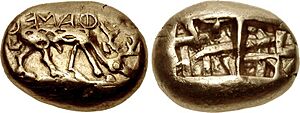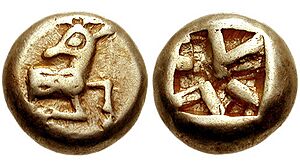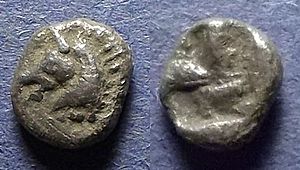History of coins facts for kids
The history of coins is a fascinating journey that began thousands of years ago. Coins are small, flat pieces of metal, usually round, used as money. They have been a major way for people to buy and sell things for a very long time.
Coins are also like tiny history books! They can tell us a lot about the past. They show us what languages people spoke, how governments worked, what religions were important, and how the economy was doing. They even show us the faces of rulers who made them.
The very first coins were often made from metal scraps. People would hit a hammer onto the metal, which was placed on an anvil, to shape them. In China, most coins were made by pouring melted metal into molds, a process called casting. This method also spread to places like Southeast Asia and Japan.
First Coins Ever

The earliest known coins come from the ancient city of Ephesus in what is now Turkey. Archaeologists found them deep under the ruins of the great temple of Artemis. These first coins were used as offerings to the goddess or as valuable items in the temple.
The famous Lydian Lion coins were among the first. They were made from a natural mix of gold and silver called electrum. This metal's value could change, so the royal lion symbol stamped on the coin was like a guarantee. It showed that the coin's value was approved by the ruler.
These Lydian coins led to the development of ancient Greek coinage. From there, the idea of coins spread to the Roman Empire, and then to many Western countries. The coins of the Seleucids, Parthians, and Sassanians also influenced Islamic coins. Indian coins were largely shaped by Greek, Roman, and Islamic styles. While Chinese coins likely developed on their own, they later adopted Western-style coinage. Many other countries around the world also began using Western-style coins.
The Lydian Lion coins were first made by King Alyattes of Lydia between 610 and 560 BC. At first, even the smallest electrum coins were very valuable, perhaps worth a day's pay. This meant they were too expensive for everyday shopping, like buying bread.
There's a fun story connecting coins to the famous Trojan Horse. Coins from Cyme in Aeolia had a horse symbol. This was probably a nod to the power of their royal family. Some stories even say that Hermodike II, a daughter of a king from Cyme, invented coined money after marrying King Midas. King Midas was famous for supposedly turning everything he touched into gold!
However, the real King Midas lived before coins were invented. The connection to King Midas comes from the fact that Lydian electrum came from the Pactolus river. This was the river where King Midas supposedly washed away his golden touch. King Alyattes's ability to collect taxes might have been the real "Midas touch" that helped fund his conquests.
Some very early metal pieces, without clear images, were used in the city of Miletus and on the island of Samos. But the horse-head silver coins from Cyme, made around 600-550 BC, are important. They are considered candidates for the second oldest coins and perhaps the first used for everyday buying and selling by the Ionian Greeks. This helped spread the idea of market economics around the world.
Since these early times, coins have been the most common form of money. The first coins were made of electrum, a natural pale yellow mix of gold and silver, sometimes with added silver and copper.
Later, the Persian daric became the first gold coin. Along with the silver siglos, these coins set the standard for using both gold and silver as money in the Persian Empire. This system continued for a long time. Persian coins were very well known in cities like Susa and Ctesiphon.
Some of the most famous ancient coins that people still collect today are Roman coins and Greek coins. The Byzantine Empire also made many coins, including thin gold coins with images of the Christian cross and different Byzantine emperors.
In the 7th century, the Umayyad Caliphate minted silver dirham and gold dinar coins.
In China, a tomb from the Shang dynasty (around 11th century BCE) shows what might be the first cast copper money, called Tong Bei. By the Warring States period and the Han dynasty, coins were widely used. Many Chinese coins had a hole in the center so they could be tied together on a string.
Even today, silver and gold coins are very common and recognized worldwide. Mints still make millions of them, like the Canadian Silver Maple Leaf and the American Gold Eagle. Coins made of copper, nickel, and other metals are also common, but usually for smaller amounts of money.
Celtic coinage was made by the Celts from the late 4th century BC to the mid 1st century AD.
How Coins Were Made
The earliest coins were made by hand. This process is called hammered coinage. A metal piece was placed on an anvil, and a hammer was used to strike it. The front of these early electrum coins often had detailed pictures, but the back usually had simple punch marks. The shape and number of these marks depended on the coin's value and weight.

The very first coins had a "rough incuse" on the back, which was just the mark left by the hammer. Later, a "punch" was used, often a "square incuse," to make the hammer strike more accurate. Sometimes, this even created a swastika pattern. Over time, these punches started to have their own designs, leading to coins with designs on both sides.
Some early lion coins are covered with many small marks, sometimes more than ten! These marks were probably added by moneychangers and bankers. They would put their mark on coins they believed had the correct weight and metal mix. This helped them quickly recognize good coins later, as fake coins were common.
In China, most coins were made by casting. This means melted metal was poured into molds. This method spread to Southeast Asia and Japan. While governments rarely cast coins outside of China, it was a common way for counterfeiters to make fake coins.
Since the early 1700s, presses have been used in the West to make coins. These started with screw presses and later became steam-powered presses in the 1800s. The first presses were developed in France and Germany and quickly came to Britain. Today, modern minting uses electric and hydraulic presses.
The way a coin is made (hammered, milled by a press, or cast) affects what metals can be used. For example, very rare antimony coins are almost always cast. This is because antimony is brittle and would break if hammered or pressed.
See also
- Achaemenid coinage
- Ancient Chinese coinage
- Ancient Greek coinage
- Coinage of India
- Parthian coinage
- Sasanian coinage
Images for kids
-
610–560 BC Lydian electrum coin denominated as 1⁄3
-
Greek drachma of Aegina. Obverse: Land turtle / Reverse: ΑΙΓ(INA) and dolphin. The oldest turtle coin dates 500 BCE




